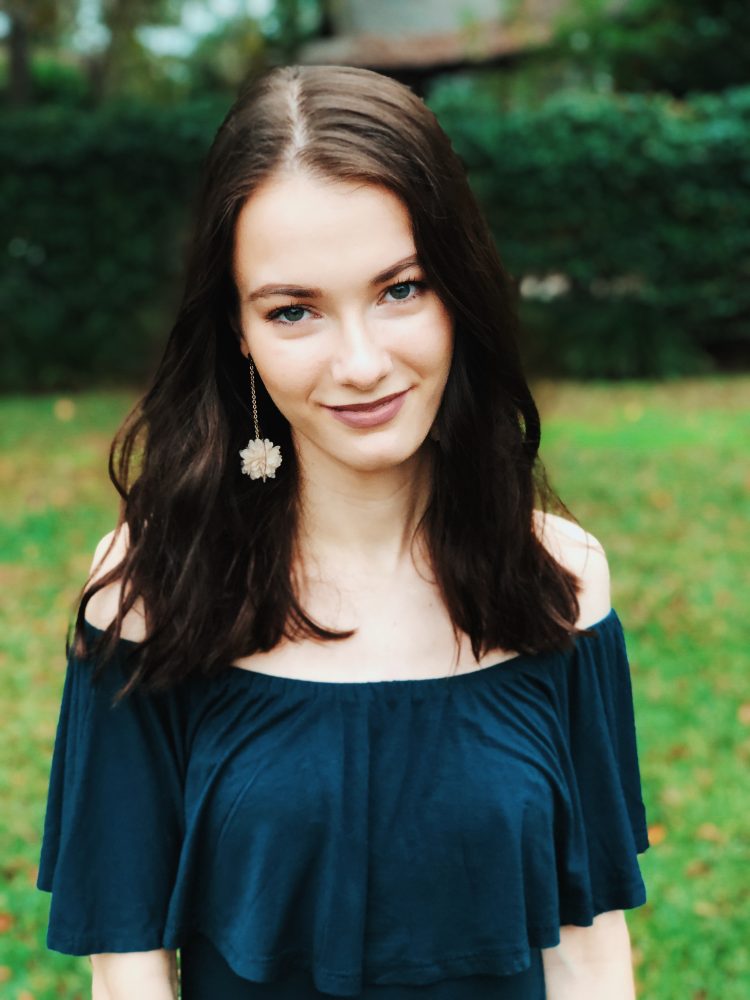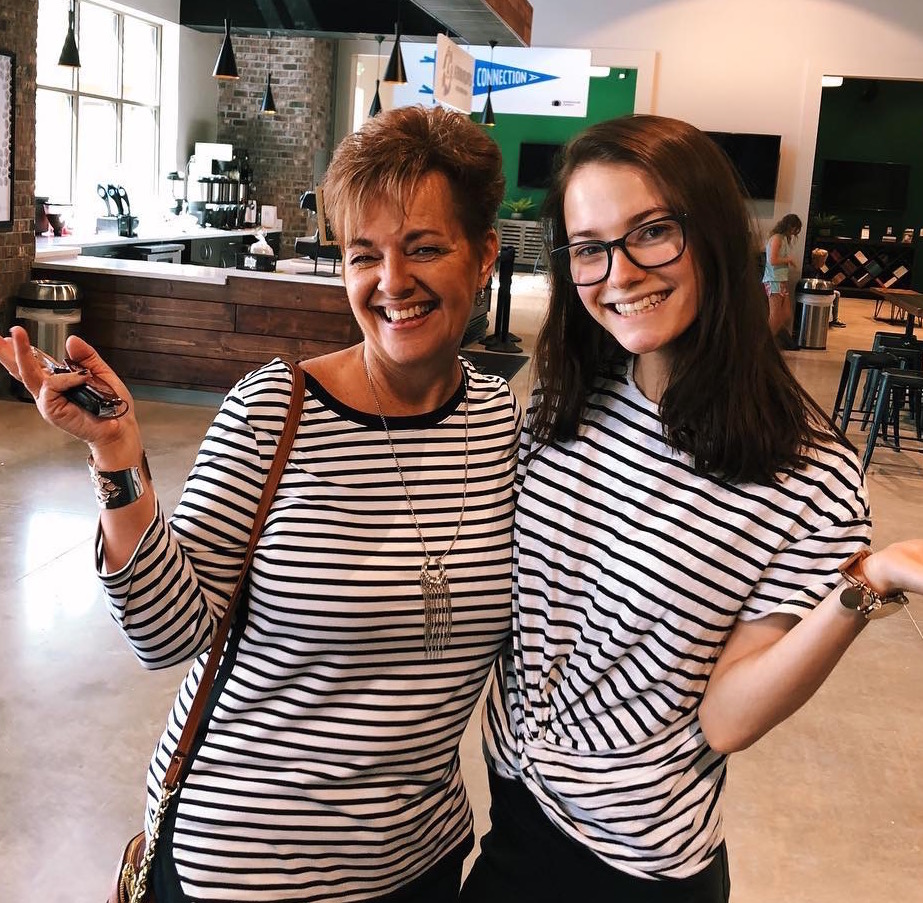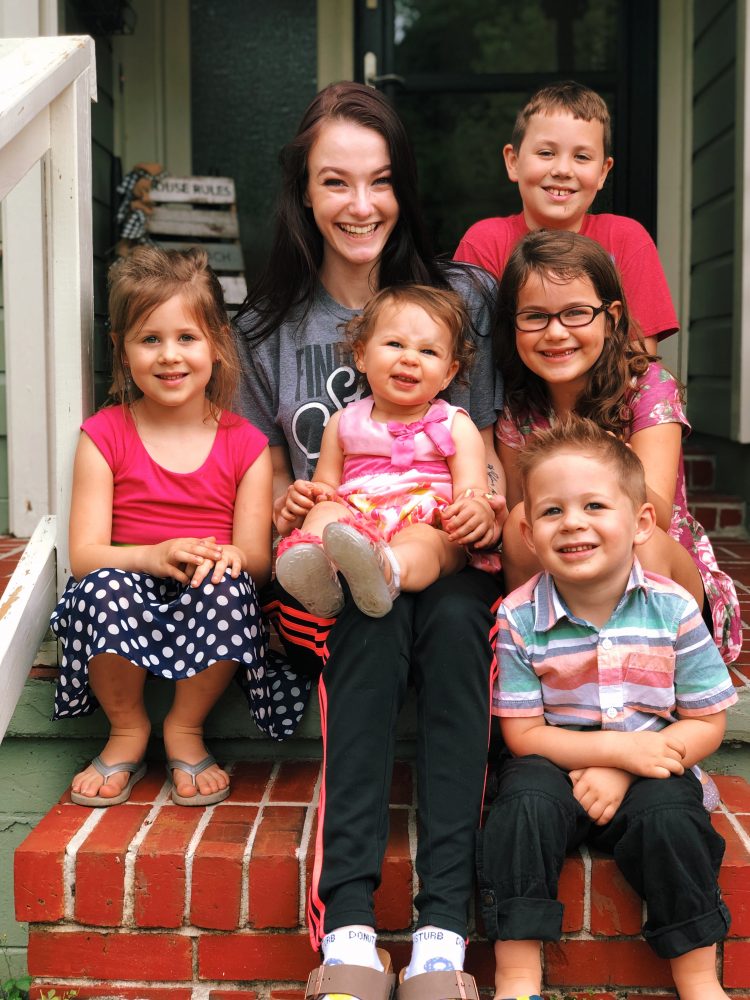A Survivor’s Quest
By Meredith Sheldon | April 22, 2018
A young woman conquered her darkest thoughts. Now, she is on a mission to prevent youth suicide.
A bell echoes through the hallways of this Gainesville middle school, and one by one, the students file into their history class.
They settle into their desks and wait for their teacher. But today, someone else is at the front of the room: a young woman who, on many counts, is lucky to be alive.
Gabrielle Benefield faces the class. She struts a white t-shirt with the word “empowered” splashed across the front. It represents her state of being. She looks the kids in the eyes. This is Benefield’s moment.
“Today, I can stand here and say, ‘I love my life,'” she tells the class.
It’s a sentiment that escaped Benefield in the past. A few years ago, she felt stuck in a dark world, one that was the opposite of the upbeat life she lives today.
She is one of the millions of young Americans who struggle with mental illness and dabble with thoughts of harming themselves. Or worse.
She survived to see the light again. On this day, she is here to spread a message of hope.
Lost in the dark
Five eternal years ago, Benefield could hardly stand the reflection of herself.
At her parents’ home in Newberry, the 15-year-old stood in her bathroom, her blue eyes glaring into the foggy vanity mirror. Her hair, uncombed and disheveled, was forced into a tangled knot. She picked up her toothbrush, but even the most mundane of morning rituals had become too much. The thought of cleaning her teeth seemed exhausting.
Days seemed long and tedious. She was home-schooled, and by mid-afternoon, she should have been plunged deep into her English homework. Or maybe it was a church youth group meeting day. It didn’t matter.
She often lay in the darkness. She lived in the darkness. That’s where she found solace.
Depressing thoughts consumed the girl who wore the brightest smile. When she was little, she was known for putting on a show. She’d dress in a Hannah Montana wig, perform her favorite dance and belt a Disney song into her glittery microphone. Her laughter and smile were contagious.
Benefield grew up in a close-knit family. Almost every night of the week, five plates were set at the dinner table. She was close to her half-brothers Stephen and Matthew.
She hailed from a devout Christian family and on weekends, she prayed at a neighborhood church and on weeknights, she studied the bible. The family felt strong and connected through their faith.
As Benefield got older, she took a liking to fashion and beauty. She wore the latest trends and her makeup looked professionally done. Outwardly, she projected a picture-perfect life. She fooled her followers on Instagram. Inside, Benefield was hurting.
Behind the makeup were bags under her eyes from crying too much, and behind the upscale outfit was a fragile, exhausted body that just wanted to be in bed.
Benefield transformed from a bubbly and charismatic girl into a lonely, depressed teenager who hid behind a mask.

Benefield smiles in her front yard before dinner with her family. Even in her darkest days, Benefield says she would hide her sadness behind cute clothes and nice makeup.
She herself doesn’t know what caused her life to flip. Her mother, Joyce Benefield, says she can’t pinpoint any one cause either. For a while, her mother thought Benefield’s anxiety, outbursts of emotion and drastic mood swings were hormonal. Perhaps it was puberty, she thought.
But Benefield’s moods worsened. Her highs and lows became extreme. Her mom hoped that one day her daughter would just snap out of it. That one day she’d wake up and be her normal, smiling self.
On good days, Benefield and her mom went shopping at Target or ventured to a spa for a manicure. On bad days, they would get in the car and just drive. They rarely spent hours apart.
One day, her mother realized Benefield wasn’t getting better. The ominous cloud hovering above her daughter’s head hadn’t wavered in months. It was the summer before her junior year of high school, and Benefield started to feel trapped in her thoughts.
They were loud, persistent and vicious.
She thought about self-harming. She thought about ending the pain.
It became a constant internal battle. She knew somewhere in the back of her mind that she would never end her life. But she no longer trusted herself.

She looked to her faith and prayed for the thoughts to disappear, but they consumed her. Benefield walked into her mother’s room and sat down on the bed. She looked her mom in the eyes and said, “If I’m not here tomorrow, would anybody care?”
Shock jolted through her mother.
“I was devastated,” her mom recalls. “How can this be?”
Thoughts of suicide and self-harm had become routine for Benefield. Not even her mother, her best friend and confidante realized the extent of what she was going through.
Living with a mental illness
Once Benefield opened up, her mom immediately sought help.
She consulted her pediatrician, visited a psychiatrist and then searched for a counselor. At age 16, Benefield received a diagnosis of depression.
She was not unlike so many youth who who struggle with a mental illness. It’s defined by the Centers for Disease Control and Prevention as conditions that affect a person’s thoughts, feelings, moods or behaviors. They range from depression and anxiety to bipolar disorder and schizophrenia.
They can start early in a child’s life and worsen from added stressors, increased social demands, lack of access to health care, poverty and weak family support, says Dr. Andres Pumariega, a pediatric psychiatrist at UF Health Shands.
Orlando Merced-O’Neill’s battle began in the third grade.
He felt tormented by school bullies who called him a freak for his quirky personality. He hid under tables and felt anxious to engage in conversation.
By middle school, he was stuck and alone. Thoughts of ending his life ruled him. He thought about suicide, which is the second leading cause of death among middle school, high school and college students, according to the CDC.

Mental illnesses can be a underlying cause for suicide, says Arthur Stockwell, president of the National Alliance for Mental Illness in Gainesville.
Finding someone to confide in, whether it is a parent, friend or counselor, is helpful to overcome struggles with mental illness. Now 19, Merced-O’Neill says he opened up to his guidance counselor before it was too late.
Others battling mental health conditions look to support groups or programs. Stockwell says his organization is working to increase the number of mental health support groups and course offerings to accommodate all the people who are seeking help.
Stockwell says the alliance in Gainesville typically caps its support groups or programs at around 18 attendees. But, In the last few months, more than 50 people have showed up.
Valeria Hernandez’s family is from Venezuela and it was difficult for her loved ones to understand her mental illness.

Throughout high school, thoughts of suicide and numbness felt normal to Hernandez. She passed off her extreme emotions as teenage angst. But by college, negative thoughts began overtaking her world. She felt unmotivated to live and eventually attempted to take her own life four years ago.
Hernandez’s friends warned that if she spoke about her mental illness and suicide attempts, she would never get a job. People would see and label her as “crazy” or a “psycho.”
She was determined to change that. She recorded a TedX Talk at the University of Florida, confessing her inner-most hopes and fears. She wanted to spark a conversation on what seemed like a forbidden topic.
“It’s time for us to come together and be comfortable in the uncomfortable,” Hernandez says in her speech.
Stigma still remains a major barrier for kids suffering with a mental health condition.
Bringing suicide and mental illness directly into conversation helps people find relief, says Dr. Sunni Lutton, the suicide prevention coordinator at UF.
“It’s like bringing the elephant in the room,”Dr. Lutton says. “We just got to keep removing the taboo. We got to keep talking about it.”
Lutton says to ask people directly if they are considering suicide or self-harm to help them find and receive the help they need.
Talking about mental health also helps society recognize that mental illness is not something to be ashamed of, Hernandez says.

“People aren’t afraid to go to the doctor if they have a sore throat or if they are having a fever,” she says. “I think mental health should be approached the same way.”
The more people talk about their mental illness, the less scary it seems, Hernandez says. While Hernandez is on the other side of her battle with mental health, it is something that will always be a part of her.
Hernandez graduated from UF with honors, was inducted to the UF Hall of Fame and plans to attend Indiana University to pursue a degree in higher education.
Prevention: Is it possible?
Suicide is preventable, say mental health experts and survivors who have thought about it. It’s a line often heard in reference to Newtown and Parkland, and from survivors like Hernandez, Merced-O’Neill and Benefield.
But for some, the path out of darkness is too steep.
There’s a lot of people who think that suicide is 100% preventable, but I think in some situations I don’t know if it’s going to be possible.
Mary Bowers spent years helping her daughter Brook fight mental illness.
Brook grew up a star athlete and an award-winning scholar. At her high school in Wisconsin, she set records for swimming, medaled in track and received academic scholarships.

She was the life of the party, her mom remembers.
Brook spiraled after losing her boyfriend to suicide in high school and experiencing sexual abuse when she was young, her mom recalls. Brook lived with mental health conditions ranging from borderline personality disorder, bipolar disorder, depression and an eating disorder.
Bowers said she did everything to get her daughter the help she needed. Brook spent years in and out of hospitals, took antidepressants, saw psychiatrists and therapists, moved in with her parents, and visited a number of psychology clinics and mental health providers.
Some days were better than others, but she says Brook couldn’t escape her pain no matter how hard she fought.
“There’s a lot of people who think that suicide is 100 percent preventable, but I think in some situations I don’t know if it’s going to be possible,” Bowers says.
Ways to help prevent suicide, she recommends, is by sharing survivors’ stories, having survivors work with other survivors and getting out the message that there is a road to recovery.
The survivor to survivor communication is key, Bowers says. While she was in and out of hospitals, Brook talked to others with similar experiences.
She helped others even when she couldn’t help herself, Bowers says.
Bowers lost her daughter Brook in 2012. She was 31.
Ending the Silence
Back at Gainesville’s Howard Bishop Middle School, Benefield tries to inspire the students.
She also enjoys interacting with younger kids and often cares for children at her church’s playroom. She stretches her arms wide, an invitation for a hug for the toddlers who come here for day care.

At 20, Benefield has managed to turn her life around. She enjoys being a nanny to her “kiddos.”She says they give her life more meaning.
When she is not running around with kids, she sits down to study for an online degree in Christian Counseling from Liberty University.
After her diagnosis, Benefield began taking anti-depressant medication. After months of therapy, she started to see light.
She refers to her journal as a reminder of her past. Inside are her notes to God pleading for help. There are stickers she saved from her church youth group and a receipt from her first psychiatric appointment.
This journal is where Benefield chronicled her struggle with depression. Every page is a reminder and every word is a memory of her dark high school years.
Writing was her outlet. Her journal was her safe space.
She now accepts her mental illness as a part of her. She accepts that she may have to confront it every single day. Now, in the classroom, Benefield stands tall in front of the middle schoolers. Sometimes, she can see a reflection of her darker self in their eyes,
“Life is anything but easy,”she tells them. “But life is also so amazing and so beautiful.”
Benefield tells them to hold on through hard times; take on the challenges life presents. They make you who you are, she says.
She is living proof.
If you or anyone you know is in crisis, please call the National Suicide Prevention Lifeline at 800-273-8255, text TALK to 741-741 or visit SpeakingOfSuicide.com/resources.
 Special Report from WUFT News
Special Report from WUFT News